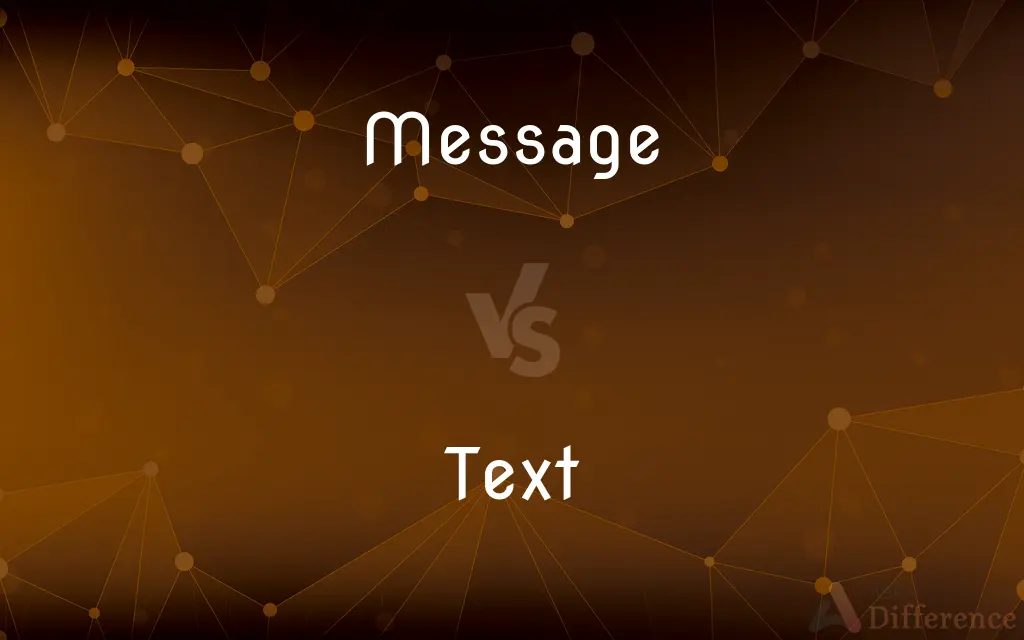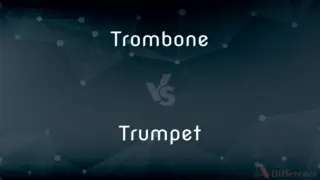Message vs. Text — What's the Difference?
By Fiza Rafique & Maham Liaqat — Updated on April 3, 2024
A message is a broad term for any type of communication conveyed by words, sounds, or signals, whereas a text specifically refers to written or printed words.

Difference Between Message and Text
Table of Contents
ADVERTISEMENT
Key Differences
A message can be delivered in various forms including verbal, written, or digital formats, aiming to convey information, emotions, or intentions from one entity to another. It's the content of communication, regardless of the medium. On the other hand, a text is explicitly a collection of written or printed words, arranged in a manner to communicate an idea, story, or information. It is one of the many mediums through which a message can be conveyed.
Messages are integral to both personal and professional communication, serving to exchange information, express feelings, or execute commands. They can be as simple as a facial expression, a gesture, an email, or as complex as a detailed report. Texts, while a subset of messages, focus exclusively on the written form, from a brief note to lengthy novels or documents. This specificity makes text a crucial component of recorded knowledge and literature.
The flexibility of a message's form means it can be adapted to suit the context, audience, and purpose, from spoken words in a conversation to a coded signal transmitted between devices. Text, due to its tangible nature, provides a permanent record of communication, essential for documentation, legal evidence, and historical records. This permanence allows for detailed analysis and interpretation across time.
In the digital age, the distinction between message and text has blurred, especially with the prevalence of texting as a form of messaging. However, the essence remains: all texts can be messages, but not all messages are texts. Digital platforms have expanded the way texts are created, shared, and consumed, making written communication more instantaneous and accessible.
Communicating effectively involves choosing the appropriate form of a message to ensure clarity and understanding. While texts offer precision and permanence, other forms of messages, such as verbal or non-verbal cues, provide immediacy and emotional nuance that texts might lack. This highlights the importance of context in determining the effectiveness of communication.
ADVERTISEMENT
Comparison Chart
Definition
Any form of communication conveying information.
Written or printed words conveying information.
Medium
Varied (verbal, written, digital, signals).
Written or printed.
Purpose
To convey information, emotions, or intentions.
To communicate ideas or information in written form.
Form
Flexible (can be non-verbal, verbal, or written).
Fixed (written words).
Permanence
Can be ephemeral or permanent, depending on the form.
Generally permanent, as it is recorded.
Examples
Speech, email, gesture, coded signal.
Books, letters, articles, digital texts.
Digital Era Role
Expanded through digital communication methods.
Made more instantaneous and accessible via texting.
Emotional Nuance
Can be present, especially in verbal forms.
Limited to what can be conveyed through writing.
Compare with Definitions
Message
A verbal, written, or recorded communication sent to or left for a recipient who cannot be contacted directly.
She left a message on his voicemail.
Text
The main body of a book or other piece of writing, as distinct from other material such as notes, appendices, and illustrations.
The text of the article starts on page two.
Message
Information transmitted through a communication system.
The satellite transmitted the data as encrypted messages.
Text
Words or a book considered in terms of their content rather than their physical form.
The text explores themes of love and loss.
Message
A short communication sent from one person to another.
He sent me a message asking when I would arrive.
Text
The written or printed material regarded as conveying the authentic or primary form of a particular work.
I prefer reading the text in its original language.
Message
An underlying theme or idea.
The message of the movie is hope and redemption.
Text
The wording of anything written or printed; the structure formed by the words in their order; the very words, phrases, and sentences as written.
The lawyer examined the text of the contract for loopholes.
Message
A significant point or central theme, especially one that has political, social, or moral importance.
The keynote speaker delivered a powerful message about climate change.
Text
A book or other written or printed work, regarded in terms of its content rather than its physical form.
The professor assigned a list of texts for the course.
Message
A message is a discrete unit of communication intended by the source for consumption by some recipient or group of recipients. A message may be delivered by various means, including courier, telegraphy, carrier pigeon and electronic bus.
Text
A book or other written or printed work, regarded in terms of its content rather than its physical form
A text which explores pain and grief
Message
A verbal, written, or recorded communication sent to or left for a recipient who cannot be contacted directly
If I'm not there leave a message on the answerphone
Text
The main body of a book or other piece of writing, as distinct from other material such as notes, appendices, and illustrations
The pictures are clear and relate well to the text
Message
A significant political, social, or moral point that is being conveyed by a film, speech, etc.
A campaign to get the message about home security across
Text
A written work chosen or set as a subject of study
Too much concentration on set texts can turn pupils against reading
Message
An errand
He would run those interminable messages after school to the bookie
Text
A text message
Just give us a call or send us a text
Message
Send a message to (someone), especially by email
I was messaged by a Californian contact for some information
The software package incorporates messaging, scheduling, and workflow functions
Text
Fine, large handwriting, used especially for manuscripts.
Message
A usually short communication transmitted by words, signals, or other means from one person, station, or group to another
I found the message you left at my desk. She sent me a quick message by email.
Text
Send (someone) a text message
If she was going to go she would have texted us
Message
The substance of such a communication; the point or points conveyed
Gestured to a waiter, who got the message and brought the bill.
Text
The original words of something written or printed, as opposed to a paraphrase, translation, revision, or condensation.
Message
A statement made or read before a gathering
A retiring coach's farewell message.
Text
The words of a speech appearing in print.
Message
A basic thesis or lesson; a moral
A play with a message.
Text
Words, as of a libretto, that are set to music in a composition.
Message
To send a message to.
Text
Words treated as data by a computer.
Message
To send as a message
Messaged the report by cable.
Text
A text message.
Message
To send a message; communicate.
Text
The body of a printed work as distinct from headings and illustrative matter on a page or from front and back matter in a book.
Message
A communication, or what is communicated; any concept or information conveyed.
We've just received an urgent message from the President.
Text
One of the editions or forms of a written work
After examining all three manuscripts, he published a new text of the poem.
Message
An underlying theme or conclusion to be drawn from something.
The main message of the novel is that time heals all wounds.
Text
Something, such as a literary work or other cultural product, regarded as an object of critical analysis.
Message
An errand.
Text
A passage from the Scriptures or another authoritative source chosen for the subject of a discourse or cited for support in argument.
Message
See groceries, shopping.
Text
A passage from a written work used as the starting point of a discussion.
Message
To send a message to; to transmit a message to, e.g. as text via a cell phone.
Just message me for directions.
I messaged her about the concert.
Text
A subject; a topic.
Message
To send (something) as a message; usually refers to electronic messaging.
She messaged me the information yesterday.
Please message the final report by fax.
Text
A textbook.
Message
(intransitive) To send a message or messages; to be capable of sending messages.
We've implemented a new messaging service.
The runaway computer program was messaging non-stop.
Text
To send a text message to
She texted me when she arrived at the airport.
Message
(obsolete) To bear as a message.
Text
To communicate by text message
He texted that he would be late.
Message
Any notice, word, or communication, written or verbal, sent from one person to another.
Ehud said, I have a message from God unto thee.
Text
To key or send text messages
She was texting in class and missed what was said.
Message
Hence, specifically, an official communication, not made in person, but delivered by a messenger; as, the President's message.
Text
A writing consisting of multiple glyphs, characters, symbols or sentences.
Message
A messenger.
Text
A book, tome or other set of writings.
Message
To bear as a message.
Text
(colloquial) A brief written message transmitted between mobile phones.
Message
A communication (usually brief) that is written or spoken or signaled;
He sent a three-word message
Text
(computing) Data which can be interpreted as human-readable text.
Plain text
Message
What a communication that is about something is about
Text
A verse or passage of Scripture, especially one chosen as the subject of a sermon, or in proof of a doctrine.
Message
Send a message to;
She messaged the committee
Text
(by extension) Anything chosen as the subject of an argument, literary composition, etc.
Message
Send as a message;
She messaged the final report by fax
Text
(printing) A style of writing in large characters; also, a kind of type used in printing.
German text
Message
Send a message;
There is no messaging service at this company
Text
(transitive) To send a text message to; i.e. to transmit text using the Short Message Service (SMS), or a similar service, between communications devices, particularly mobile phones.
Just text me when you get here.
I'll text the address to you as soon as I find it.
Text
(intransitive) To send and receive text messages.
Have you been texting all afternoon?
Text
(dated) To write in large characters, as in text hand.
Text
A discourse or composition on which a note or commentary is written; the original words of an author, in distinction from a paraphrase, annotation, or commentary.
Text
The four Gospels, by way of distinction or eminence.
Text
A verse or passage of Scripture, especially one chosen as the subject of a sermon, or in proof of a doctrine.
How oft, when Paul has served us with a text,Has Epictetus, Plato, Tully, preached!
Text
Hence, anything chosen as the subject of an argument, literary composition, or the like; topic; theme.
Text
A style of writing in large characters; text-hand also, a kind of type used in printing; as, German text.
Text
That part of a document (printed or electronic) comprising the words, especially the main body of expository words, in contrast to the illustrations, pictures, charts, tables, or other formatted material which contain graphic elements as a major component.
Text
Any communication composed of words.
Text
A textbook.
Text
To write in large characters, as in text hand.
Text
The words of something written;
There were more than a thousand words of text
They handed out the printed text of the mayor's speech
He wants to reconstruct the original text
Text
A passage from the Bible that is used as the subject of a sermon;
The preacher chose a text from Psalms to introduce his sermon
Text
A book prepared for use in schools or colleges;
His economics textbook is in its tenth edition
The professor wrote the text that he assigned students to buy
Text
The main body of a written work (as distinct from illustrations or footnotes etc.);
Pictures made the text easier to understand
Common Curiosities
How does digital communication affect the distinction between message and text?
Digital communication blurs the lines between message and text, as texts become a primary form of messaging through platforms like email and texting, combining the immediacy of messaging with the permanence of written text.
Is body language considered a message or a text?
Body language is considered a form of non-verbal messaging, as it conveys information through gestures, expressions, and movements rather than through written words.
Can a text contain multiple messages?
Yes, a single text can convey multiple messages, each with different meanings or intentions, depending on the context and the reader's interpretation.
How important is context in understanding messages and texts?
Context is crucial in accurately interpreting both messages and texts, as it provides the necessary background information to understand the intended meaning and nuances.
How do cultural differences impact the interpretation of messages and texts?
Cultural differences can significantly impact how messages and texts are interpreted, as cultural contexts influence the meanings associated with words, symbols, and non-verbal cues.
Can a text change its message over time?
While the text itself remains unchanged, its interpreted message can vary over time as societal norms and languages evolve, altering how the text is understood by different generations.
What role does technology play in the evolution of texts and messages?
Technology has greatly expanded the accessibility and immediacy of both texts and messages, enabling new forms of communication like texting and social media, which combine elements of both.
Can the same text convey different messages to different people?
Yes, individual experiences, knowledge, and perspectives can lead to varied interpretations of the same text, with each reader extracting different messages.
What is the significance of encryption in messages?
Encryption enhances the security of messages, ensuring that only intended recipients can access and understand the content, which is particularly important in digital communication.
How do emojis and emoticons fit into the distinction between messages and texts?
Emojis and emoticons add emotional nuance and context to texts, making them more similar to face-to-face messages by conveying tones and expressions that written words might lack.
What challenges are there in translating texts and messages across languages?
Translation challenges include capturing the original tone, meaning, and cultural nuances, as direct word-for-word translations may not convey the same message or emotional impact.
Share Your Discovery

Previous Comparison
Next vs. Beside
Next Comparison
Trombone vs. TrumpetAuthor Spotlight
Written by
Fiza RafiqueFiza Rafique is a skilled content writer at AskDifference.com, where she meticulously refines and enhances written pieces. Drawing from her vast editorial expertise, Fiza ensures clarity, accuracy, and precision in every article. Passionate about language, she continually seeks to elevate the quality of content for readers worldwide.
Co-written by
Maham Liaqat















































